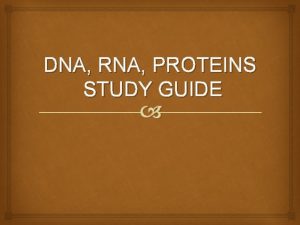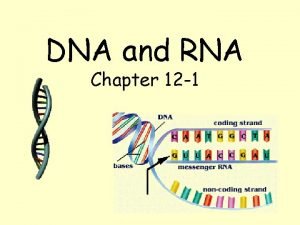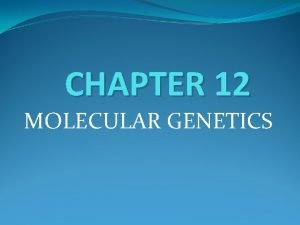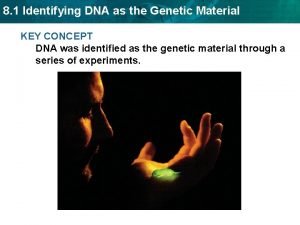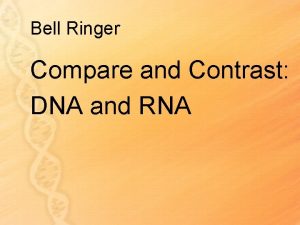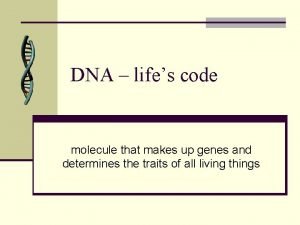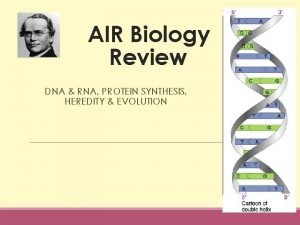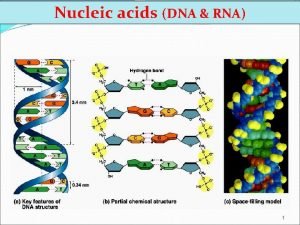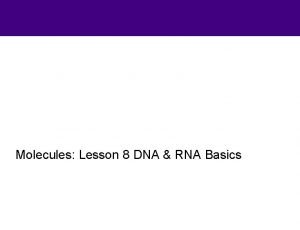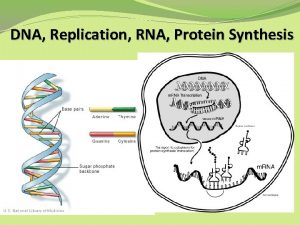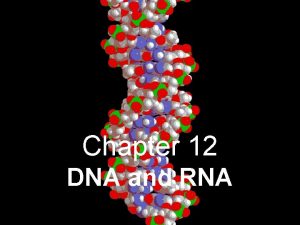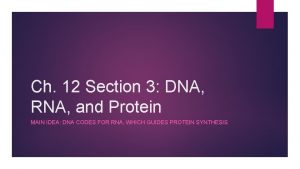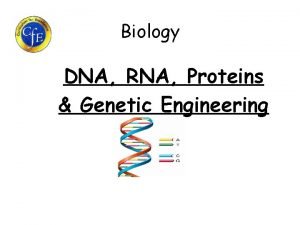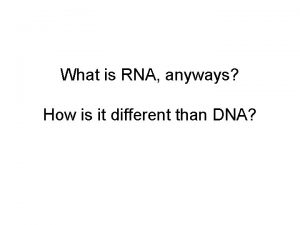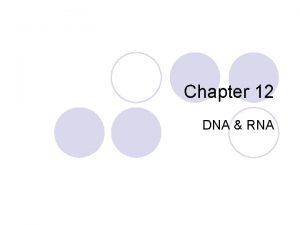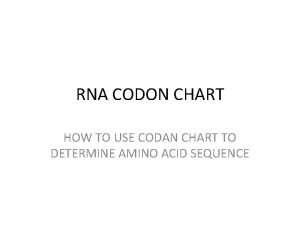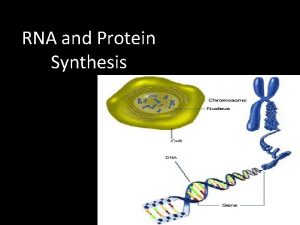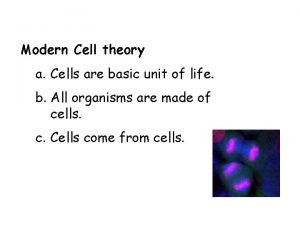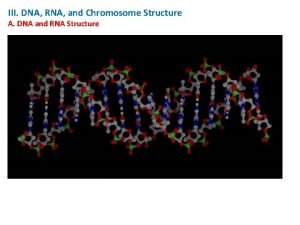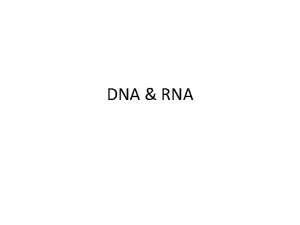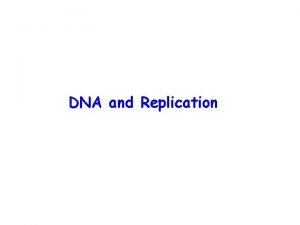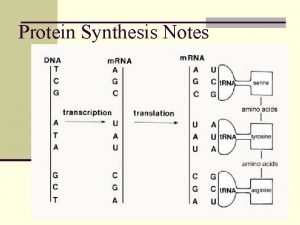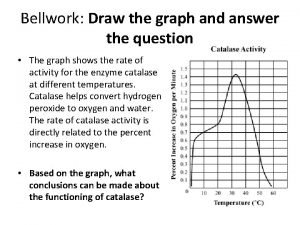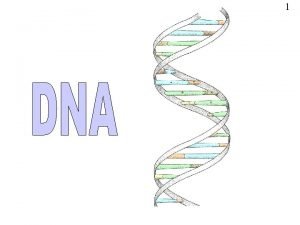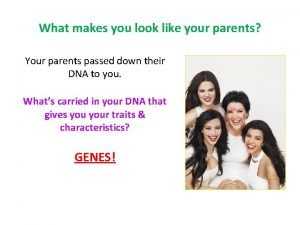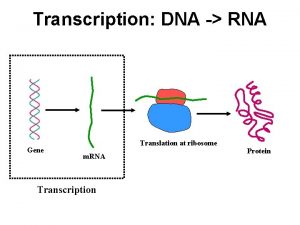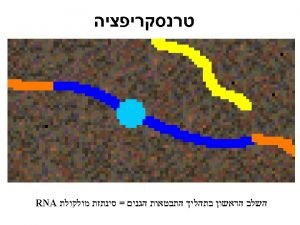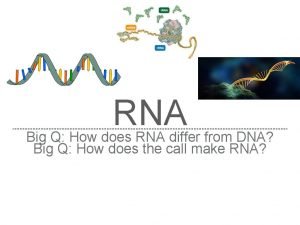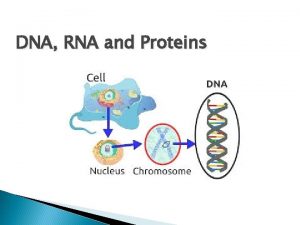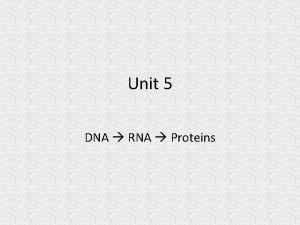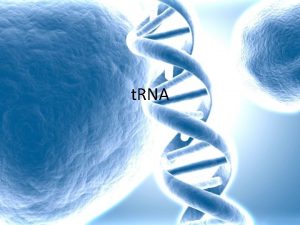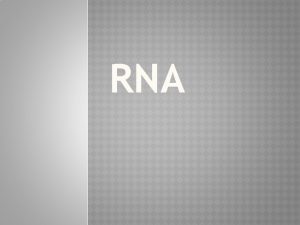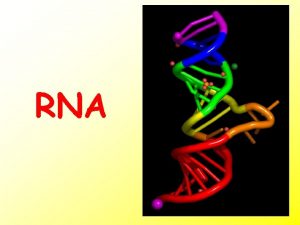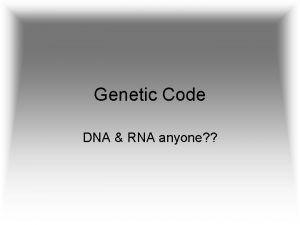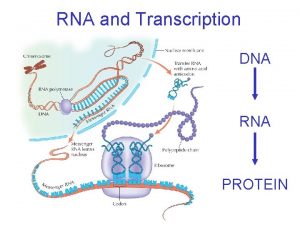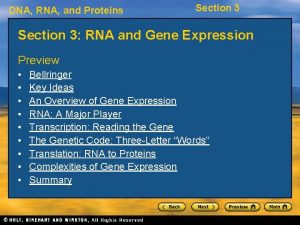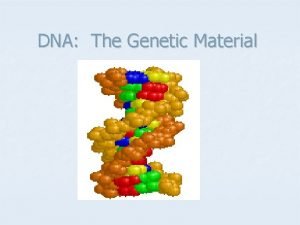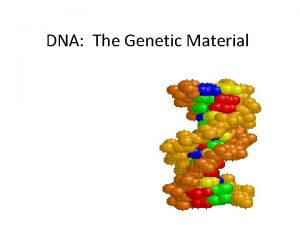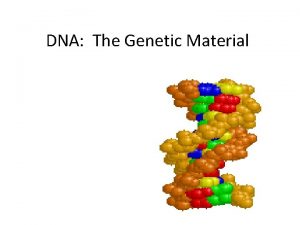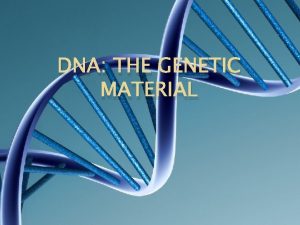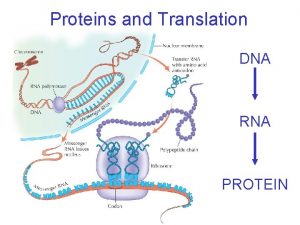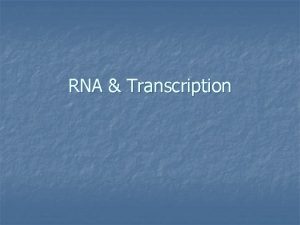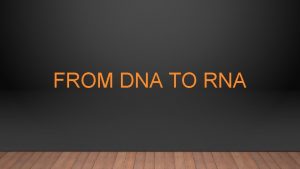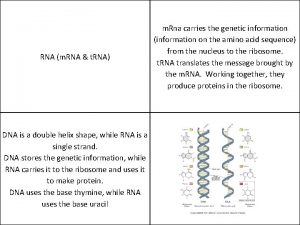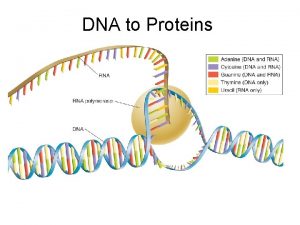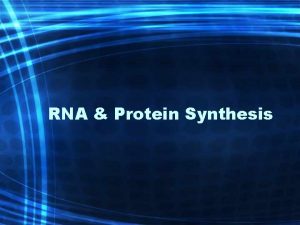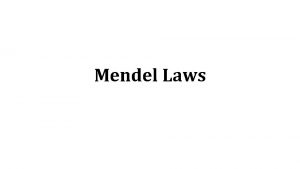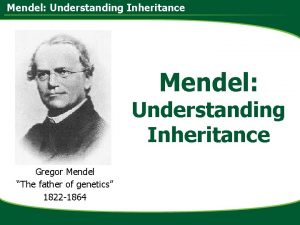DNA RNA and Proteins DNA Genetic Material Mendel










































- Slides: 42

DNA, RNA and Proteins

DNA Genetic Material � Mendel showed that traits are passed from parent to offspring. � Genetics: Instructions for how genes are inherited.

� Genes are made up of segments of DNA: Deoxyribonucleic acid. � DNA is the primary material that causes recognizable, inheritable characteristics in related groups of organisms.

Genetic Material � DNA is composed of four nucleotide subunits: ◦ Each nucleotide has the same five carbon sugar molecule and phosphate group but different nitrogenous bases: �Adenine �Guanine �Cytosine �Thymine

Shape of DNA � Winding stair case made of nucleotides � Double helix shape � Each side has a ◦ Phosphate backbone ◦ 5 carbon sugar ◦ Nitrogen base paired to the next unit

Information in DNA � Pyrimidines: Thymine and Cytosine (T&C) � Purines: Adenine and Guanine (G&A) � DNA is in the shape of a spiral stair case/ double helix of two complementary strands of nucleotides.

Base Pairing Rule �A always binds with T � G always binds with C � So A=T and G=C � Purine always binds to pyrimidine � Watson, Franklin and Crick discovered 3 D model.

Chargaff’s observation �A =T �G = C � Base rule pair


Activity � Read and summarize Watson and Cricks model of DNA on 346. � K, W, L ◦ Knew ◦ Would like to learn more about ◦ Learned

Class activity �Draw, label and explain a strand of DNA including the nucleotide subunits, base pairing and complementary strands.

� Video � DNA about Watson, Franklin and Crick

DNA Replication � DNA replication: the process of making a copy of DNA. (synthesis in the cell cycle) 1. 2. 3. In DNA replication, the DNA molecule unwinds, and the two sides split. Then new nucleotides are added to each side until two identical sequences result. DNA replication occurs before a cell divides so that each cell has a complete copy of DNA.

Video � DNA replication Mc. Graw Hill � http: //highered. mcgraw- hill. com/olcweb/cgi/pluginpop. cgi? it=swf: : 53 5: : 535: : /sites/dl/free/0072437316/120076/ micro 04. swf: : DNA%20 Replication%20 Fork

Unwinding and Separating DNA Strands � The double helix unwinds. � Complementary strands of DNA separate from each other and form Y shapes areas are called replication forks.

Adding Complementary Bases � At the replication fork, new nucleotides are added to each side according to the base pairing rules. � The original two strands serve as a template for two new strands.

Formation of Two Identical DNA Molecules � DNA replication produces two identical DNA molecules

Replication Proteins � During the replication of DNA, many proteins form a machinelike complex of moving parts.

DNA Helicase � DNA helicases unwind the DNA double helix during DNA replication. � This process causes the helix to unwind and forms a replication fork.

DNA Polymerase � Proteins called DNA polymerases catalyze the formation of the DNA molecule. � The polymerases add nucleotides that pair with each base to form two new double helixes. � DNA polymerases also have a “proofreading” function. � During DNA replication, errors sometimes occur, and the wrong nucleotide is added to the new strand. DNA polymerase cannot add another nucleotide unless the previous nucleotide is correctly paired.

Prokaryotic and Eukaryotic � In prokaryotic cells, replication starts at a single site. In eukaryotic cells, replication starts at many sites along the chromosome.

Prokaryotic DNA Replication � Prokaryotic cells usually have a single DNA molecule, or chromosomes. Prokaryotic chromosomes are a closed loop, may contain protein, and are attached to the inner cell membrane.

Eukaryotic DNA Replication � While prokaryotes have a single chromosome/loop, eukaryotic cells often have several chromosomes. � By starting DNA replication at many sites along the chromosome they can replicate their DNA faster than prokaryotes, two distinct replication forks form at each start site, and replication occurs in opposite directions.

Eukaryote Both Chromosomes Replication fork Several replication sites Faster Bigger pro Closed loop (1) 1 replication site Slower Smaller

Activity � Create a comic strip explaining DNA replication of a eukaryotic organism using all proteins and correct terminology. � You ◦ ◦ ◦ ◦ need three steps including these words Rep fork DNA helicase DNA polymerase Template strand New strand Base pair rule nucleotide

RNA and Gene Replication � Proteins perform most of the functions of cells. DNA provides the original “recipe”. � RNA: ribonucleic acid allows genetic information to be taken from DNA and proteins be made. � Gene expression: the manifestation of genes into specific traits (geno determines pheno)

Transcription: DNA to RNA � The first stage of gene expression. � RNA is making proteins from the information found in DNA. � 1. DNA 2. RNA 3. Protein

Translation: RNA to Proteins � Second stage of gene expression. � Information form RNA is used to make specific proteins.

RNA: Major Player � In cells three types of RNA complement DNA and translate the genetic code into proteins. � RNA vs. DNA RNA Both DNA Uracil four bases Thymine one strand of nucleotides carry genetic information two strands of nucleotides


Read the paragraph “ Functions of RNA” on page 363 and then answer these questions for your type of RNA � Name: � Function: � Order 1 st 2 nd 3 rd (only choose 1) � Description/fun fact

1, 2, 3 page 363 � 1 – messenger RNA � 2 – transfer RNA � 3 – ribosomal RNA � 1 share with other 1’s � Then 1, 2, 3

Types of RNA � Messenger RNA: carries instructions for a gene to the site of translation. � Transfer RNA: reads the messenger m. RNA sequence. � Ribosomal RNA: found in ribosomes, transports proteins from the ER as they are produced.

Transcription: Reading the Gene � During transcription , the information in a specific region of DNA (a gene) is transcribed, or copied into RNA. � Step 1: RNA polymerase binds to the promoter ( a specific DNA sequence/start location). � Step 2: RNA polymerase unwinds the dbl helix to expose both paired nucleotide bases. � Step 3: RNA polymerase links and binds complementary base units to each strand of DNA. � The result once the stop codon is reached is one strand of m. RNA is produced.


Transcription vs. Replication Transcription Both Replication m. RNA is made, using portions of each strand of DNA use DNA as a template. DNA is made, using both entire strands of DNA

Translation: RNA to proteins � Translation occurs in a sequence of steps, involves three kinds of RNA and results in a complete polypeptide.

Genetic Code: 3 letter “words” � Each 3 nucleotide sequence is called a codon. � Each codon unit codes for a specific amino acid. � There are 20 amino acids that are possible.

� Transcribe �A and then translate this sequence: TCGGCGGGATTTATTCCCG

� Transcribe � ATC � Now and then translate this sequence: GGC GGG ATT TAT TCC CGA use the codon chart to determine which amino acids this codes for.

Complexities of Gene Expression � The relationship of gene expression is complex. � Despite the neatness of the genetic code, every gene cannot be simply linked to a single outcome.

Homework � Complete the handout by transcribing and translating the sequence to produce a protein
 Dna rna and proteins study guide answers
Dna rna and proteins study guide answers Chapter 11 dna and genes
Chapter 11 dna and genes Chapter 12 section 1 dna the genetic material
Chapter 12 section 1 dna the genetic material Chapter 12 section 1 dna the genetic material
Chapter 12 section 1 dna the genetic material Section 12-1 dna
Section 12-1 dna Chapter 12 dna the genetic material
Chapter 12 dna the genetic material Chapter 12 section 1 dna the genetic material
Chapter 12 section 1 dna the genetic material Section 1 identifying dna as the genetic material
Section 1 identifying dna as the genetic material How is genetic drift different from gene flow
How is genetic drift different from gene flow Genetic programming vs genetic algorithm
Genetic programming vs genetic algorithm Genetic programming vs genetic algorithm
Genetic programming vs genetic algorithm Genetic drift vs genetic flow
Genetic drift vs genetic flow What is the difference between genetic drift and gene flow
What is the difference between genetic drift and gene flow Compare and contrast dna and rna.
Compare and contrast dna and rna. What provides instructions for protein synthesis
What provides instructions for protein synthesis What is the goal of replication
What is the goal of replication Complete the following venn diagram
Complete the following venn diagram Dna double helix coloring worksheet answer key
Dna double helix coloring worksheet answer key Protein synthesis
Protein synthesis Phosphodiester bonds
Phosphodiester bonds Rnabases
Rnabases Fraction
Fraction Lenine
Lenine Chapter 12 dna and rna
Chapter 12 dna and rna Chapter 12 section 3 dna rna and protein
Chapter 12 section 3 dna rna and protein Rna and protein synthesis study guide
Rna and protein synthesis study guide Dna and rna
Dna and rna What is rna
What is rna Chapter grabber
Chapter grabber Histidine codon
Histidine codon Dna and rna similarities
Dna and rna similarities Guac wheel
Guac wheel Structure of chromosome
Structure of chromosome Frederick griffith transformation
Frederick griffith transformation Minor groove
Minor groove Unlike dna, rna
Unlike dna, rna Cytoplasm structure
Cytoplasm structure Dna to rna rules
Dna to rna rules What is code 1
What is code 1 Dna to protein steps
Dna to protein steps Dna to rna transcription
Dna to rna transcription Rna or dna
Rna or dna How does rna differ from dna? *
How does rna differ from dna? *
